The Rocks That Make up the Atlantis Massif
Rocks That Make up the Atlantis Massif-A Detective Story about Peridotites, Harzburgites, Gabbros, and Serpentinites
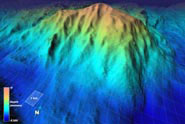 |
|
Atlantis Massif
|
The Atlantis Massif rises 14, 000 feet above the surrounding seafloor. Faulting and mass wasting (land slides) associated with the Atlantis Transform Fault or Fracture Zone, have dissected the mountain, resulting in a rugged and embayed southern face. Because of these processes, the core or inside of the mountain is now exposed and we can learn about this mountain by mapping it and sampling it with Alvin or with remotely operated vehicles. Figuring out the history, however, is difficult detective work and we still have a lot to learn.
During the field program in 2000, we explored a very small portion of this mountain with Alvin and recovered over 200 rock samples. Investigation of these rocks tells us a remarkable story about how the mountain was formed, what it is made of and how Lost City came into being. To understand what an amazing > 2 million history this massif has experienced we must first learn a bit about what the names of the rocks are and how they are formed, altered and aged as they move up and away from the spreading axis of the Mid-Atlantic Ridge.
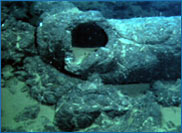 |
|
Volcanic Basalt
|
Mantle: If you could slice through the Earth from it’s inner-most core at 6,371 km beneath the surface of the planet, to its outer shell, you would find a variety of solid, dense metals in the hottest interior (perhaps as hot at 4,300°C or >7000°F!), that are surrounded by an outer core of liquid metals. Continuing to move outward into the mantle, you would then encounter solid rock towards the cooler, outer surface of the planet. Eventually, at the outer-most crust of the ocean basins, you would find submarine volcanoes made of the volcanic rock basalt.
The reason that the materials in the Earth are stratified to form distinct layers is because during very early formation of our planet, melting and overturn by convection caused differentiation to occur such that the densest materials sank into the core of the Earth and the less dense materials floated to the surface. Over millions of years, volcanic and subduction zone activity associated with plate tectonics, have continued to change the composition of the rocks that make up Earth.
Peridotites: The rocks that make up the mantle beneath the Mid-Atlantic Ridge (as well as other ridges and beneath the continents) are called peridotites. The mineral olivine makes up 40-90% of peridotite rocks. As we will see later, this turns out to be profoundly important in the formation of the Lost City. Olivine has the general formula (Mg, Fe)2SiO4, which tells us that it is made up of magnesium (Mg), iron (Fe), silica (Si), and oxygen. In peridotites, olivine contains much more Mg than Fe. The minerals diopside (MgSiO3), enstatite [CaMg(SiO3) 2], and chromite (FeCr2O4) and rarely plagioclase (CaAl2Si2O8) make up the remainder of peridotites (Ca=calcium, Cr = chromium, Al-aluminum) beneath mid-ocean ridges and basins. Many of these minerals are impure, meaning that they may contain trace amounts of other chemical species.
Harzburgites: From looking at the mantle rocks we recovered from the Atlantis Massif, we see that they are made up of about 10-15% diopside, and 85-90% olivine, with a little bit of chromite. Geologists shorten this long description by giving this type of rock a different name called harzburgite.
Discovery 1. So, the first discovery in this detective story is that most of the rocks that make up the Atlantis Massif are rocks that were initially formed deep in the mantle and are called harzburgites. We have also discovered that these rocks are very rich in magnesium, but also contain a little bit of silica, calcium, and iron (and other trace metals and chemicals).
To understand the rocks that make up the Massif, a second question to figure out is “How do rocks formed deep in the mantle get exposed on the surface? To get at this question, you need to think back to the discussion above and remember that 1) the core of the Earth is very hot (perhaps as hot at 4,300°C), and the surface of the planet is much cooler (e.g. the water at the seafloor is cold (~ 2-4°C or nearly freezing). Because of this gradient in temperature from the core to the outer shell, circulation cells are created in the mantle beneath the spreading centers that cause the mantle rocks to rise buoyantly towards the surface. As this plastic-like rock material wells up, it begins to melt because it is under less and less pressure.
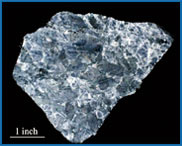 |
|
Gabbro
|
Gabbros: The melt that forms is less dense so that it rises buoyantly towards the surface – much of this melt eventually ponds at depths of 1-5 km in the shallower portions of the crust beneath the ridges to form crustal magma chambers. The minerals that have the lowest temperatures of melting melt first, and therefore, the melts that pond have a very different composition than the mantle rocks. For example, the melts are much richer in silica, and poorer in magnesium and have the same composition as the volcanic rocks called basalt. Melts that cool slowly overtime within the magma chambers are called gabbros. We see evidence of these fossilized magma chambers beneath Lost City because we find gabbro veins and small lenses of gabbro preserved in the side of the mountain.
Discovery 2. The harzburgitic rocks are residual mantle material that is left after melting. During upwelling, the mantle rocks have moved to depths of perhaps 10 km or less beneath the seafloor. There are also remnants of slowly cooled melt in the form of abundant veins made of the rock gabbro.
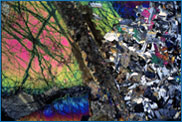
Several thousand years ago, the Mid-Atlantic Ridge near the Atlantis Fracture Zone may have been more magmatically active. During this time period, the magma chambers may have become over pressurized due to an influx of new melt from the mantle, and their roofs may have fractured. The basaltic material that rushed upward from the chamber likely traveled through a planar, narrow rift called a dike, and if this dike breached the seafloor, it would have resulted in an eruption of basalt. Material in the dikes cools slower than the gabbroic rocks, and we call these medium grained rocks diabase. The basalts cool extremely fast because they are subjected to near freezing water, and they are very fine-grained. Commonly, the melt cools so fast or is quenched such that crystals do not have time to form. Therefore, flow surfaces of basalts are commonly coated with a thin layer of jet-black glass, which looks like obsidian.
However, we believe that at the Mid-Atlantic Ridge near Lost City, several 10’s to perhaps a 100,000 years or more may go by before a volcanic eruption occurs. But, spreading or rifting still goes on...and on…. As the oceanic crust is transported away from the spreading axis, it is cooled by hydrothermal circulation. The processes of cooling and the pull-apart motion of the plate due to spreading results in the formation of very large axial valleys that may be 20 km across and 4 km deep. Such valleys typify the Mid-Atlantic Ridge, particularly near areas of large transform faults. These processes also result in the formation of extensive deep cracks and fissures, and long-lived faults. The fracture systems and faults allow significant amounts of seawater to circulate to depth, which causes important changes to occur in the both the composition and the mineralogy of the rocks.
The linked rifting and faulting processes are also important in bringing the deep mantle rocks to the surface of the Mid-Atlantic Ridge. During long periods of spreading that are not associated with volcanic activity, the crust is extensively thinned—there are not any volcanic flows to cover it. It seems amazing, but along many portions of the Mid-Atlantic Ridge peridotites are commonly exposed right within the axial valley! Some researchers suggest that along this ridge, as much as 20% of the rocks exposed on the surface of the seafloor are mantle rocks.
Discovery 3. Spreading of the Mid-Atlantic Ridge and circulation of seawater to depth causes severe extension of the crust, resulting in the formation of large faults and fissures, and modification of the chemistry and composition of the rocks that make up the crust and upper mantle.
Serpentinites: Because the minerals that comprise the mantle were initially formed at much higher temperatures and pressures, these rocks are highly susceptible to alteration. Even at room temperature and pressure, new minerals will replace the minerals in peridotites if they are bathed in water. The mineral that forms when olivine undergoes alteration is a magnesium-rich mineral called serpentine. Serpentine is sort of a garbage can in terms of the chemicals it can be made of (it takes chemicals from both the rock as well as the fluid), such that there are actually three different kinds of serpentine minerals with different structures. You may know one of them as asbestos. However, in submarine systems, the most common serpentine mineral is called chyrsotile, which has a general formula Mg3Si2O5(OH)4. One important thing to notice is that this new mineral that is formed after olivine, includes a bunch of WATER as OH groups. We will discuss this more in the chemistry section, but this results in a 20-40 % positive change in the volume of the peridotites!! And may be one reason that the mountain that comprises the Atlantis Masssif is so tall (only 700 m below the surface of the ocean).
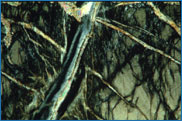 |
Because the peridotites start out with so much olivine, and olivine alters easily to serpentine, most mantle rocks that we recover do not have much olivine left. Usually the rocks are altered to 80% or greater serpentine minerals and, therefore, we call these altered mantle rocks serpentinites.
Serpentinites are altered mantle rocks that contain abundant serpentine minerals. They are common along slow-spread systems like the Mid-Atlantic Ridge, and they are very common near the outer surfaces of the Atlantis mountain. Serpentinites contain very large volumes of water and their formation results in a positive volume change of 20-40%. This process may result in the elevated topography right at the southern lip of the summit. Because the Atlantis mountain contain mostly peridotite and is of much different composition than basalts and slower cooled counterparts (i.e. gabbros), the fluids that circulate beneath Lost City have dramatically different compositions than black smokers.